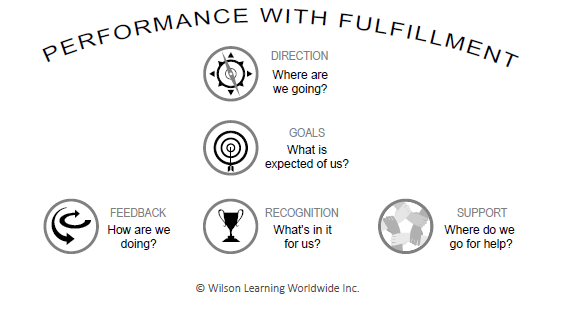Here’s a Thought About Practical Tips for Managing Day-to-Day Employee Virtual Interactions
(28 de octubre de 2020)

This is the third installment of Wilson Learning’s “Here’s a Thought About . . .” leadership development series. These brief explorations look at challenges faced by L&D professionals and offer thoughts, trends, and tips for preparing well-equipped leaders to lead organizations forward from a new workplace.
The current pandemic and economic crisis are shining a very bright spotlight on leadership around the world, illuminating the fact that truly effective leaders are critical but rare, while ineffective leaders’ deficiencies are being exposed.
“Good and effective leaders, those who people choose to follow, are now seen as critical and essential to keep employees engaged and help the organization succeed in this time of crisis.
In contrast, poor leaders are now being exposed for what they are—weak and ineffective—because, quite frankly, there is no place to hide.”
—Tom Roth, COO, Wilson Learning Worldwide Inc.
Harsh? Perhaps, but our research examining performance and engagement, spanning decades and numerous organizations, continually points to the single biggest contributor of employee engagement: the day-to-day interactions between employees and their direct managers. Emerging from this research are five key questions employees have of their managers—the answers determine if employees stay engaged and performing at their best.
Everything Has Changed, Nothing Has Changed
Admittedly, everything has changed about the environment in which leaders are managing day-to-day employee interactions. Employees are no longer in the office, large group meetings are few or nonexistent, and performance reviews are conducted over Zoom. In short, the way in which managers and employees interact has changed dramatically in a very short period of time.
But nothing has changed in regard to the needs of employees—both their psychological needs to keep them engaged and their work needs to maintain high performance. Employees still need to feel optimistic about their company’s future, still need clear goals and objectives, and still need a manager who is both compassionate and honest about performance. These are the core elements of Wilson Learning’s five critical leadership practices that were pioneered in the 1980s. Wilson Learning’s leadership framework has, does, and will continue to equip leaders with skills and practices that are essential to inspire the very best from their people.
In light of the current situation, let’s revisit these five steadfast leadership practices with practical tips and insight into how leaders need to think and behave differently in this changing world.
Five Critical Leadership Practices and Practical Tips


1. Direction: Where Are We Going?
While others have long talked about business being in a VUCA environment (Volatile, Uncertain, Complex, and Ambiguous), it is best to leave this term for times like right now. Companies have literally thrown out long-term strategies, replacing them with short-term crisis management.
But, employees need for an answer to the question, “Where are we going?” has not disappeared and, in fact, has intensified. Employees are yearning for a sense of optimism about their company’s, and their own, future.
Leadership often does a good job of communicating the vision and strategy of the organization. Now, it is even more critical to help employees recognize the value of their contribution in the context of that vision and strategy.
While stability has been bashed against the pandemic and economic crisis wall, people still need to feel a sense of hope for their company’s future and need reassurance that their work is meaningful. Leaders must deliver a healthy dose of realistic optimism, communicating the organization’s potential going forward while acknowledging there will still be struggles. Leaders need to talk openly about what is achievable when answering the question that may be wrought with instability: “Where are we going?”

2. Goals: What Is Expected of Us?
People need clear, achievable goals. Leaders must ensure goal setting is dynamic, mutually understood, and connects work goals to the interests and talents of the employee.
Now, more than ever, goals need to be focused on the short term and updated frequently. Due to uncertain and changing situations, goals may change more frequently or pivot for emerging opportunities; it is up to leaders to communicate this to their people.
Emphasis needs to be placed on ensuring employees understand what is expected of them as they work from home rather than in the office. Leaders, who now have less direct contact with their employees, also need to communicate the importance of employees taking personal accountability for their outcomes.

3. Feedback: How Are We Doing?
Feedback has been called the lifeblood of an organization. Giving effective feedback reinforces, redirects, and inspires desired behaviors and outcomes.
Now is not the time to leave employees in the dark, wondering what is going on or how they are doing. In the absence of information and feedback, people will make up their own story—usually more negative and inaccurate than the truth. Frequent feedback, of any type, keeps the lifeline open and is essential for leadership effectiveness. Providing more frequent feedback is also important to give employees the information they need to monitor and adjust their own behavior and hold themselves personally accountable.
It is equally as important for leaders to solicit feedback on their own actions and decisions, especially when working remotely. Virtual meetings are perceived as being more public than in-person meetings, so employees are often more reluctant to offer feedback to their manager. Managers need to be more diligent in seeking feedback and more open to receiving it in today’s environment. Leaders also need to be more transparent and own when mistakes do occur. Mistakes and misunderstandings are inevitable; leadership needs to take responsibility for those moments and correct them in order to maintain trust.

4. Recognition: What’s In It for Us?
Now is the absolute worst time to allow employees to go unrecognized. Leaders need to accelerate the frequency and quality of employee recognition to ensure people feel valued for their hard work. Employees need to know that seemingly simple things they are doing make an even bigger difference now.
Often times, leaders wait until someone does “something big” before they offer recognition or rewards, but leaders also need to recognize smaller contributions. It is equally as important for leaders to provide recognition for outcomes, as all of the work that went into that outcome may not always be apparent.
In today’s virtual office space, email also takes on more significance when leaders aren’t able to recognize people face-to-face. Copying key people on these emails can make this recognition more widely known to others in the organization and gives employees the credit they deserve.
Small gestures, such as sending flowers or a small gift on their birthday, an e-card to celebrate an accomplishment, or providing them with an opportunity to lead a virtual meeting can go a long way in helping people feel valued and recognized.

5. Support: Where Do We Go for Help?
The leader’s role in providing resources and removing obstacles to performance with fulfillment looks different in a virtual environment.
Leaders may need to set up peer-to-peer contact points for work- or task-related support, rather than being the sole support person. People are also going to need much more support in their personal lives, outside of work. Leaders can play an important role in understanding, empathizing with, and supporting employees, even if they are not in a position to do anything to help resolve the situation.
Here’s a Thought About . . . Regularly Scheduled, Intentionally Selected Communication
In times of change, it is impossible to over-communicate. Informal, spontaneous communication that facilitated opportunities for collaboration, creativity, feedback, recognition, and support inside day-to-day interactions have all but vanished as we work inside of our own walls. Today, and going forward, leaders will need to regularly schedule and intentionally select ways to communicate, whether by email, teleconferences, or Zoom-type meetings.
To learn more about how to advance leadership character throughout your organization, contact Wilson Learning.








 Por favor, complete este formulario para suscribirse para recibir artículos y ponencias.
Por favor, complete este formulario para suscribirse para recibir artículos y ponencias.





